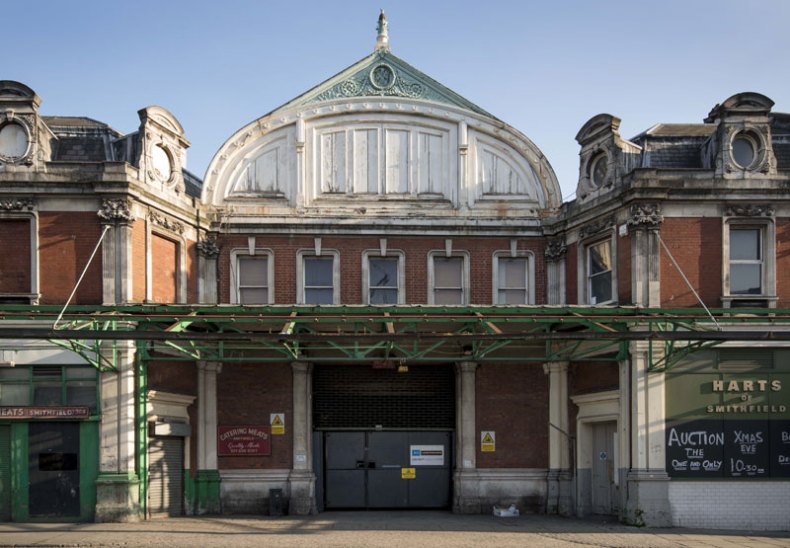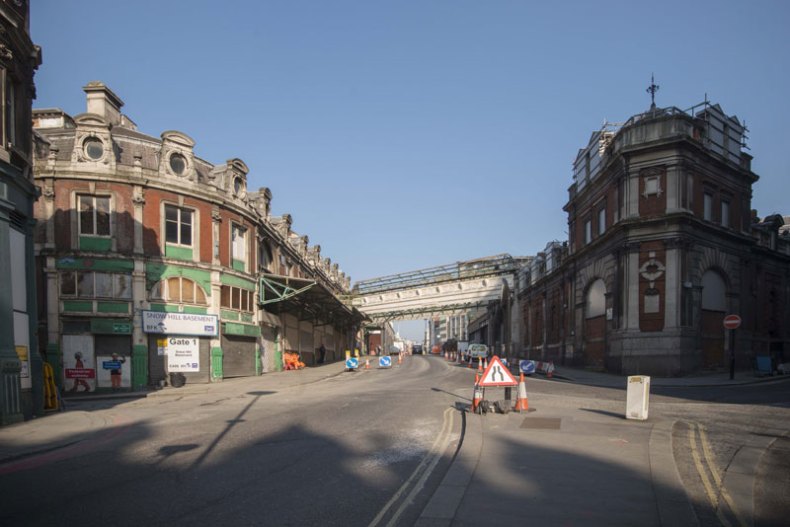Zac Goldsmith, the Conservative candidate to be the next mayor of London, was recently asked by a BBC journalist to name the location of the Museum of London. Goldsmith was stumped: ‘The Museum of London is…where is the Museum of London…the Museum of London. I went there very, very recently…I can’t tell you where.’ And when the same journalist asked the Labour candidate Sadiq Khan to name the oldest museum in the city, the politician simply made up an institution on the spot: ‘Is it…er…the History Museum?’ he asked. One of these museum buffs will take the reins at City Hall in the second week of May – assuming they can find it, that is.
Goldsmith’s disorientation seems particularly unfortunate, and not only because one might expect a prospective mayor to boast basic knowledge of the major museum dedicated to the city he soon hopes to run. It is also inopportune because the next mayoral term will coincide with the relocation of the Museum of London through what, with construction costs already mooted at £150 million, looks set to be one of the largest capital projects undertaken by the city’s museums in the next decade.

Smithfield General Market, the new site of the Museum of London. © Museum of London
The museum plans to move from its current premises on the perimeter of the Barbican complex, where it is short of space (and, yes, difficult to find), to the vacant Smithfield General Market and adjacent buildings, which include the imposing Red House, one of the first cold stores to be built in Britain. This scheme was given the go-ahead in January this year, following the rejection of a lumpen development plan that would have seen the Victorian market halls gutted, destroying Horace Jones’s characterful 1879 building, and the site plugged with offices. Now, six architectural teams have been shortlisted to provide designs for a new museum to be housed in the buildings, which will in effect become part of the collection.
The project catches the strange dynamic in which any city-focused museum operates, caught between its responsibility to preserve material history and an understanding that it is involved in the continuing evolution of the metropolis that is its raison d’être. At the Museum of London, such a tension can be felt in the collection, which includes important archaeological finds unearthed during successive swathes of construction; the Cheapside Hoard, for instance, was discovered as workmen dismantled a timber building in 1912.
At museums of city history, the balance between design and accident is also often encapsulated by the range of the collection. They’re broad and unruly, encompassing urban and social history, biography, and archaeology, as well as the history of art in relation to the city. These are not institutions that appeal to aesthetes – but they can tell us a lot about the history of taste, and how its ideals have been compromised by life in the city.

Smithfield General Market, the new site of the Museum of London. © Museum of London
Such unevenness, and how it might approach the experience of the city itself, has always been part of the attraction of these museums: a visitor to the Musée Carnavalet in Paris, for instance, might drift from 17th-century boiseries to the keys to the Bastille, and Marcel Proust’s cork-lined bedroom. Between them, the two museums of Rome, one adjacent to Piazza Navona and the other in Trastevere, archive both the grandest official views of the city and its exuberant folk traditions.
City museums should remind us to prize the fabric of a city, and the historical memories that we would not want to lose. In transferring its collection of around 6 million objects to repurposed historic buildings, the Museum of London will, wittingly or not, also be setting a standard for all those property developers who seem so eager to forget – epitomised by how they are taking on conservation areas, listed buildings, and historic views with ever more recklessness and lack of guile. It must aim to exemplify sensitive redevelopment, while acknowledging the city’s need to accommodate change. A well-received project might encourage some of our more obstinate architects and planners to cast an eye to the past as they set about envisaging the future.
A preview from the May issue of Apollo: Subscribe here.

If you want to be mayor, you really ought to know more about London’s museums
The Museum of London, where a new concert hall is to be developed. Photo: © Museum of London
Share
Zac Goldsmith, the Conservative candidate to be the next mayor of London, was recently asked by a BBC journalist to name the location of the Museum of London. Goldsmith was stumped: ‘The Museum of London is…where is the Museum of London…the Museum of London. I went there very, very recently…I can’t tell you where.’ And when the same journalist asked the Labour candidate Sadiq Khan to name the oldest museum in the city, the politician simply made up an institution on the spot: ‘Is it…er…the History Museum?’ he asked. One of these museum buffs will take the reins at City Hall in the second week of May – assuming they can find it, that is.
Goldsmith’s disorientation seems particularly unfortunate, and not only because one might expect a prospective mayor to boast basic knowledge of the major museum dedicated to the city he soon hopes to run. It is also inopportune because the next mayoral term will coincide with the relocation of the Museum of London through what, with construction costs already mooted at £150 million, looks set to be one of the largest capital projects undertaken by the city’s museums in the next decade.
Smithfield General Market, the new site of the Museum of London. © Museum of London
The museum plans to move from its current premises on the perimeter of the Barbican complex, where it is short of space (and, yes, difficult to find), to the vacant Smithfield General Market and adjacent buildings, which include the imposing Red House, one of the first cold stores to be built in Britain. This scheme was given the go-ahead in January this year, following the rejection of a lumpen development plan that would have seen the Victorian market halls gutted, destroying Horace Jones’s characterful 1879 building, and the site plugged with offices. Now, six architectural teams have been shortlisted to provide designs for a new museum to be housed in the buildings, which will in effect become part of the collection.
The project catches the strange dynamic in which any city-focused museum operates, caught between its responsibility to preserve material history and an understanding that it is involved in the continuing evolution of the metropolis that is its raison d’être. At the Museum of London, such a tension can be felt in the collection, which includes important archaeological finds unearthed during successive swathes of construction; the Cheapside Hoard, for instance, was discovered as workmen dismantled a timber building in 1912.
At museums of city history, the balance between design and accident is also often encapsulated by the range of the collection. They’re broad and unruly, encompassing urban and social history, biography, and archaeology, as well as the history of art in relation to the city. These are not institutions that appeal to aesthetes – but they can tell us a lot about the history of taste, and how its ideals have been compromised by life in the city.
Smithfield General Market, the new site of the Museum of London. © Museum of London
Such unevenness, and how it might approach the experience of the city itself, has always been part of the attraction of these museums: a visitor to the Musée Carnavalet in Paris, for instance, might drift from 17th-century boiseries to the keys to the Bastille, and Marcel Proust’s cork-lined bedroom. Between them, the two museums of Rome, one adjacent to Piazza Navona and the other in Trastevere, archive both the grandest official views of the city and its exuberant folk traditions.
City museums should remind us to prize the fabric of a city, and the historical memories that we would not want to lose. In transferring its collection of around 6 million objects to repurposed historic buildings, the Museum of London will, wittingly or not, also be setting a standard for all those property developers who seem so eager to forget – epitomised by how they are taking on conservation areas, listed buildings, and historic views with ever more recklessness and lack of guile. It must aim to exemplify sensitive redevelopment, while acknowledging the city’s need to accommodate change. A well-received project might encourage some of our more obstinate architects and planners to cast an eye to the past as they set about envisaging the future.
A preview from the May issue of Apollo: Subscribe here.
Unlimited access from just $16 every 3 months
Subscribe to get unlimited and exclusive access to the top art stories, interviews and exhibition reviews.
Share
Recommended for you
The museum pratfalls of London’s mayoral candidates (yep, Zac AND Sadiq)
Neither Zac Goldsmith nor Sadiq Khan seem to know a thing about the capital’s museums
Boris Johnson and the GLA are the true vandals of London
The mayor’s expansionist ambitions are ruining the city’s historic character
The Museum of London is Good News for Smithfield Market
Move should improve the museum and protect Smithfield fabric